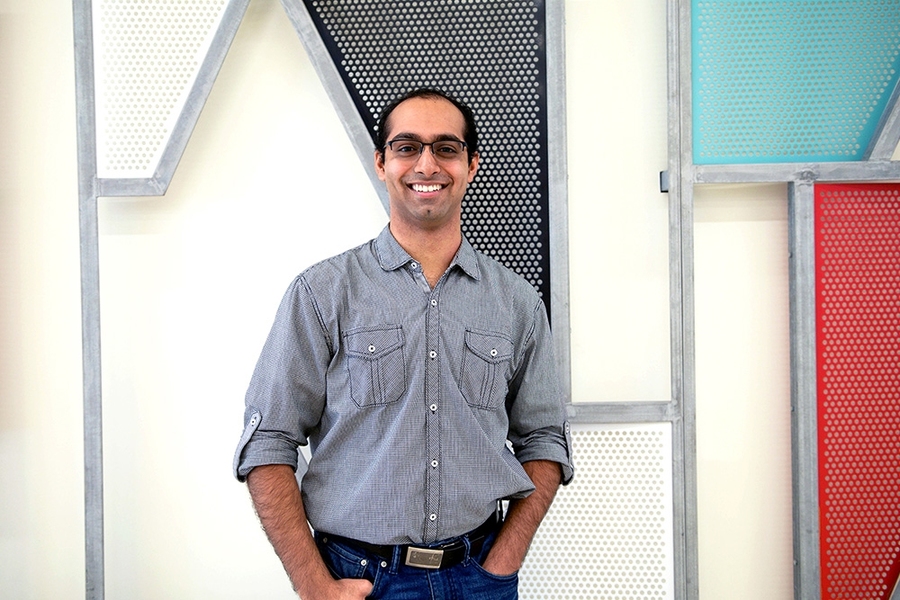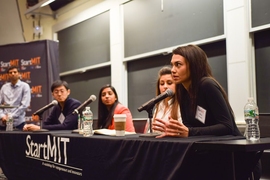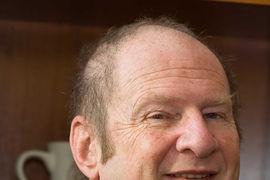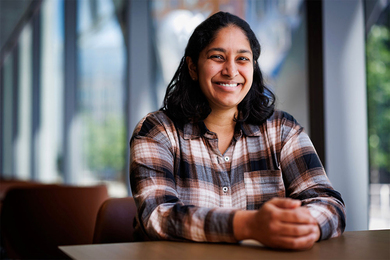“When you’re part of a community, you want to leave it better than you found it,” says Keertan Kini, an MEng student in the Department of Electrical Engineering, or Course 6. That philosophy has guided Kini throughout his years at MIT, as he works to improve policy both inside and out of MIT.
As a member of the Undergraduate Student Advisory Group, former chair of the Course 6 Underground Guide Committee, member of the Internet Policy Research Initiative (IPRI), and of the Advanced Network Architecture group, Kini’s research focus has been in finding ways that technology and policy can work together. As Kini puts it, “there can be unintended consequences when you don’t have technology makers who are talking to policymakers and you don’t have policymakers talking to technologists.” His goal is to allow them to talk to each other.
At 14, Kini first started to get interested in politics. He volunteered for President Obama’s 2008 campaign, making calls and putting up posters. “That was the point I became civically engaged,” says Kini. After that, he was campaigning for a ballot initiative to raise more funding for his high school, and he hasn’t stopped being interested in public policy since.
High school was also where Kini became interested in computer science. He took a computer science class in high school on the recommendation of his sister, and in his senior year, he started watching computer science lectures on MIT OpenCourseWare (OCW) by Hal Abelson, a professor in MIT’s Department of Electrical Engineering and Computer Science.
“That lecture reframed what computer science was. I loved it,” Kini recalls. “The professor said ‘it’s not about computers, and it’s not about science’. It might be an art or engineering, but it’s not science, because what we’re working with are idealized components, and ultimately the power of what we can actually achieve with them is not based so much on physical limitations so much as the limitations of the mind.”
In part thanks to Abelson’s OCW lectures, Kini came to MIT to study electrical engineering and computer science. Kini is currently pursuing an MEng in electrical engineering and computer science, a fifth-year master’s program following his undergraduate studies in electrical engineering and computer science.
Combining two disciplines
Kini set his policy interest to the side his freshman year, until he took 6.805J (Foundations of Information Policy), with Abelson, the same professor who inspired Kini to study computer science. After taking Abelson’s course, Kini joined him and Daniel Weitzner, a principal research scientist in the Computer Science and Artificial Intelligence Laboratory, in putting together a big data and privacy workshop for the White House in the wake of the Edward Snowden leak of classified information from the National Security Agency. Four years later, Kini is now a teaching assistant for 6.805J.
With Weitzner as his advisor, Kini went on to work on a SuperUROP, an advanced version of the Undergraduate Research Opportunities Program in which students take on their own research project for a full year. Kini’s project focused on making it easier for organizations that had experienced a cybersecurity breach to share how the breach happened with other organizations, without accidentally sharing private or confidential information as well.
Typically, when a security breach happens, there is a “human bottleneck,” as Kini puts it. Humans have to manually check all information they share with other organizations to ensure they don’t share private information or get themselves into legal hot water. The process is time-consuming, slowing down the improvement of cybersecurity for all organizations involved. Kini created a prototype of a system that could automatically screen information about cybersecurity breaches, determining what data had to be checked by a human, and what was safe to send along.
Once finished with his SuperUROP, Kini became involved in the development of Votemate, a web app designed to simplify the voter registration process in all 50 states.
Kini’s interest in Votemate wasn’t only about increasing voter registration. “I think most people in this nation are centrist, and one of the reasons our political system gets polarized is because people who are polarized primarily turn out to vote,” he says. “I think the only reliable way to fix that is to get more people to turn out to vote.”
Shaping policy on campus
Kini is also involved in making changes within the Institute. “I feel like the same interest that’s gotten me interested in policy is the same thing that’s gotten me interested in working with the Department of Electrical Engineering and Computer Science,” Kini admits.
As a member of the Undergraduate Student Advisory Group (USAGE), Kini has been involved in exploring ways to revitalize the electrical engineering curriculum, redesigning the undergraduate lounge, and compiling a list of the resources available to Course 6 students. On the reason for the list of resources, Kini recalls, “When I was a senior, I realized there were some resources that I had no idea about. And this was after I had been involved in the department and USAGE for 5 years! I should have known.”
Kini is especially interested in making sure students know about the MIT resources for prospective entrepreneurs, such as StartMIT, in which he enrolled last year.
StartMIT is an Independent Activities Period course designed to help students learn about what it takes to create a startup from the ground up. With the advice of over 60 speakers involved in the startup space, StartMIT offers practical advice on how to actually get a startup off the ground.
On the usefulness of StartMIT, Kini says, “at MIT, we try to solve very difficult challenges, we try to solve very meaningful technical problems, but what gets lost in the shuffle, is after you come up with a great idea, how do you get it out of your head and into the world?” He adds, “There’s a saying: ‘If you build it they will come.’ I disagree heartily. But StartMIT helps bridge that divide.”
Thanks to his experience at StartMIT, Kini knows that he wants to start his own company one day. “I see starting a company not only as an option, but the option. It’s a way to make sustainable change in the world.”
Looking back at his experience with USAGE, curriculum development, and policy making, Kini observes, “it’s not just about the nitty gritty of education, its about community.”









